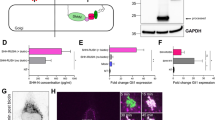Abstract
Segmentation of the Drosophila embryo is initiated by localized maternal signals. In this context, anteriorly localized Bicoid activates the gap genes in the anterior half of the embryo while posteriorly localized Nanos represses the translation of maternal hunchback mRNA to pattern the posterior half. The non-segmented termini are patterned by the localized activation of mitogen-activated protein kinase. Yet, the spatial extent of the terminal patterning system in regulating gap genes beyond poles remains unknown. We investigated the patterning potential of the terminal system using mutagenized embryos that lack both the anterior and the posterior maternal signaling systems. Using a combination of quantitative imaging and mathematical modeling, we analyzed the spatial patterns of gap genes in the early Drosophila embryo. We found that this mutant embryo develops symmetric cuticle patterns along the anteroposterior axis with two segments on each side. Notably, the terminal system can affect the expression of Krüppel in the torso region. Our mathematical model recapitulates the experimental data and reveals the potential bistability in the terminal patterning system. Collectively, our study suggests that the terminal system can act as a long-range inductive signal and establish multiple gene expression boundaries along the anteroposterior axis of the develo** embryo.
Similar content being viewed by others
Abbreviations
- OreR:
-
Oregon R
- AP:
-
Anteroposterior
- Bcd:
-
Bicoid
- Hb:
-
Hunchback
- MAPK:
-
Mitogen-activated protein kinase
- ERK:
-
Extracellular signal-regulated kinase
- dpERK:
-
Diphosphorylated ERK
- Tor:
-
Torso
- Trk:
-
Trunk
- Tll:
-
Tailless
- Hkb:
-
Huckebein
- Cic:
-
Capicua
- Gro:
-
Groucho
- FISH:
-
Fluorescent in situ hybridization
- PBS:
-
Phosphate-buffered saline
- PBST:
-
Phosphate buffered saline with 0.02% Triton X-100
- DIG:
-
Digoxigenin
- BIO:
-
Biotin
- FITC:
-
Fluorescein
- WBR:
-
Western blocking reagent
- BSA:
-
Bovine serum albumin
- NGS:
-
Normal goat serum
- Kr:
-
Krüppel
- Kni:
-
Knirps
- Gt:
-
Giant
- GOF:
-
Gain-of-function
Reference
J. Jaeger, Manu and J. Reinitz, Curr. Opin Genet. Dev., 22, 533 (2012).
E. Wieschaus, Curr. Top Dev. Biol., 117, 567 (2016).
J. Casanova and G. Struhl, Genes Dev., 3, 2025 (1989).
W. Driever and C. Nusslein-Volhard, Cell, 54, 95 (1988).
J. Jaeger, Cell Mol. Life Sci., 68, 243 (2011).
D. St Johnston and C. Nusslein-Volhard, Cell, 68, 201 (1992).
M. Akam, Development, 101, 1 (1987).
A. Ephrussi and D. St Johnston, Cell, 116, 143 (2004).
J. Dubnau and G. Struhl, Nature, 379, 694 (1996).
R. Rivera-Pomar, D. Niessing, U. Schmidt-Ott, W. J. Gehring and H. Jackle, Nature, 379, 746 (1996).
E. De Keuckelaere, P. Hulpiau, Y. Saeys, G. Berx and F. van Roy, Cell Mol. Life Sci., 75, 1929 (2018).
R. Lehmann and C. Nusslein-Volhard, Development, 112, 679 (1991).
C. Wreden, A. C. Verrotti, J. A. Schisa, M. E. Lieberfarb and S. Strickland, Development, 124, 3015 (1997).
M. Furriols and J. Casanova, Embo J., 22, 1947 (2003).
C. M. Smits and S. Y. Shvartsman, Curr. Top Dev. Biol., 137, 193 (2020).
A. Mineo, M. Furriols and J. Casanova, Open Biol, 8, 180180 (2018).
E. Cinnamon, A. Helman, R. Ben-Haroush Schyr, A. Orian, G. Jimenez and Z. Paroush, Development, 135, 829 (2008).
G. Jimenez, A. Guichet, A. Ephrussi and J. Casanova, Genes Dev., 14, 224 (2000).
Y. Kim, M. Coppey, R. Grossman, L. Ajuria, G. Jimenez, Z. Paroush and S. Y. Shvartsman, Curr. Biol., 20, 446 (2010).
H. E. Johnson, Y. Goyal, N. L. Pannucci, T. Schupbach, S. Y. Shvartsman and J. E. Toettcher, Dev. Cell, 40, 185 (2017).
M. Coppey, A. N. Boettiger, A. M. Berezhkovskii and S. Y. Shvartsman, Curr. Biol., 18, 915 (2008).
Y. Kim, A. Iagovitina, K. Ishihara, K. M. Fitzgerald, B. Deplancke, D. Papatsenko and S. Y. Shvartsman, Chaos, 23, 025105 (2013).
M. Ashyraliyev, K. Siggens, H. Janssens, J. Blom, A. Akam and J. Jaeger, PLoS Comput. Biol., 5, e1000548 (2009).
T. J. Perkins, J. Jaeger, J. Reinitz and L. Glass, PLoS Comput. Biol., 2, e51 (2006).
Y. Kim, M. J. Andreu, B. Lim, K. Chung, M. Terayama, G. Jimenez, C. A. Berg, H. Lu and S. Y. Shvartsman, Dev. Cell, 20, 880 (2011).
Y. Kim, Z. Paroush, K. Nairz, E. Hafen, G. Jimenez and S. Y. Shvartsman, Mol. Syst. Biol., 7, 467 (2011).
D. Papatsenko and M. S. Levine, Proc. Natl. Acad Sci. USA, 105, 2901 (2008).
Acknowledgements
We thank Dr. Eric Wieschaus for providing bcd hb nos mutant flies and for the helpful discussions. K. M. O. was supported by thesis research funds by Princeton University. Y.K. was supported by the internal fund of Electronics and Telecommunications Research Institute (ETRI) [22RB1100, Exploratory and Strategic Research of ETRI-KAIST ICT Future Technology (Grant number: N05220126)].
Author information
Authors and Affiliations
Corresponding author
Additional information
Author Contribution
K.M.O., S.Y.S., and Y.K. designed the experiments, K.M.O. and Y.K. performed the experiments. K.L., K.M.O., and J.K., performed image analysis. K.L., K.M.O., and Y.K. wrote the paper. All authors analyzed the data.
Rights and permissions
About this article
Cite this article
Lee, K., O’Neill, K.M., Ku, J. et al. Patterning potential of the terminal system in the Drosophila embryo. Korean J. Chem. Eng. 40, 436–444 (2023). https://doi.org/10.1007/s11814-022-1298-6
Received:
Revised:
Accepted:
Published:
Issue Date:
DOI: https://doi.org/10.1007/s11814-022-1298-6




